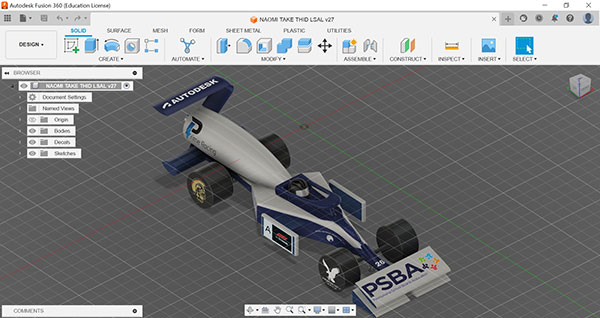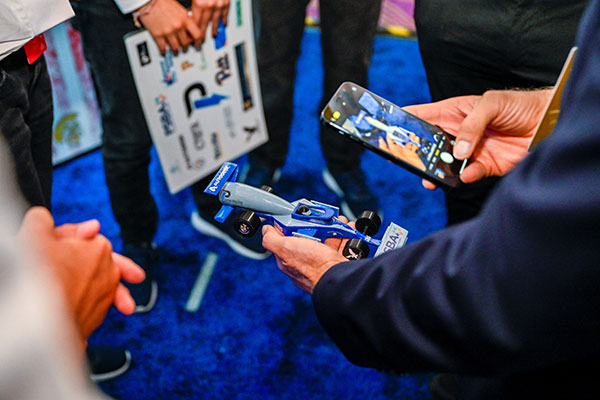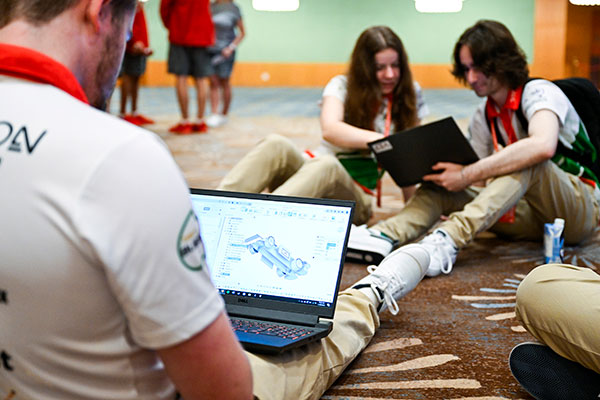
The F1 in Schools program has become a worldwide phenomenon, with students from various countries participating and learning valuable skills that can propel them into STEM careers. Images courtesy of F1 in Schools.
Latest News
November 27, 2023
F1 in Schools is an educational program and competition that leverages the excitement of Formula 1 racing to engage and inspire students in STEM disciplines. The competition launched in the UK in 2000 in just eight schools and now operates across 58 countries worldwide. It has grown to become a worldwide phenomenon, with students from multiple countries participating and learning valuable skills that can propel them into STEM careers.
F1 in Schools is a multidisciplinary challenge, in which teams of students aged 9 to 19 deploy CAD/CAM software to collaborate, project manage, design, analyze, manufacture, test and race miniature compressed-gas powered F1 cars down a 20 m track.
Autodesk, a global leader in design-and-make software, is the official CAD/CAE/CAM software partner of F1 in Schools and has been instrumental in shaping the global STEM challenge’s growth. We spoke to Conway Goh, director of Autodesk Education Experiences to learn more about this valuable program and competition.
Digital Engineering: Can you tell us about the students’ car designs and how they developed them?
Conway Goh: Students begin their journey with brainstorming and in-depth research on real Formula 1 cars, delving into aerodynamics, materials and engineering principles. Key to this process is identifying design constraints and where they need to adhere to competition rules.
Each team designs their small-scale Formula 1 car model using CAD software. Autodesk Fusion 360 serves as their primary software tool for crafting precise 3D models of their car designs.

Every component, from body to wings, wheels and internals, is meticulously modeled with Fusion 360’s capabilities. As they design, they leverage CAE tools to simulate their designs and look for ways to iterate and improve to achieve gains in structural performance and reliability. As you would expect, choosing lightweight and robust materials is paramount and students can experiment with materials like carbon fiber and lightweight plastics in these simulations.
In addition, Fusion 360’s artificial intelligence-based generative design tools enable students to quickly generate many high-performing design alternatives. This approach uses the power of AI to explore design possibilities that they would never think of on their own, and after reviewing the options, they choose the design that best fits their needs. One area where students use these tools is in the design of the wheels, as they attempt to create the lightest and strongest wheel possible.
Students are also able to harness tools like Autodesk CFD to optimize the aerodynamics, helping them shape the car for minimal drag and maximum downforce. These detailed computational fluid dynamics (CFD) simulations enable them to refine the design for peak performance, chasing those vital fractions of a second.
DE: Can you share results from the most recent competition or talk about the experience of being present at the event?
Goh: I’m truly inspired by the student competitors and their passion for design and manufacturing. I’m blown away by their ability to operate exactly like professional teams by chasing performance gains and building the best cars they possibly can. It’s not just their ability to design and build these small-scale cars, it’s the way they talk about their work and present their innovations. Through F1 in Schools holistic approach, students aren’t only building hard skills like engineering, they’re also developing the soft skills that will be crucial in their future careers.
Hearing their stories and aspirations to work in F1 or other design and engineering companies makes it all worthwhile. These students are our future leaders and will all go on to do amazing things—I’m so proud of them.
DE: How does Autodesk support innovation in education? What drove Autodesk to sponsor the event?

Goh: The partnership provides students with free access to Autodesk’s software, echoing F1 in Schools’ ambition to offer accessibility and inclusion to the competition by reaching students of all backgrounds. Beyond sponsoring the competition, we see F1 in Schools as a partner in our commitment to education.
Autodesk invests in the next generation of designers and makers by providing free, equitable access to professional software and training resources to help students prepare for the jobs of the future. Partnering with F1 in Schools allows us to provide student competitors with hands-on experience with the technology that shapes the future of the industries we serve.
DE: Anything else you’d like to tell us about the event that the above questions haven’t given you the opportunity to express?
Goh: We are immensely proud of this longstanding partnership with F1 in Schools and have worked together since 2008. This collaboration has been instrumental in nurturing the next generation of tinkerers, makers, designers and engineers. I can only imagine this partnership will continue to grow as F1 in Schools continues inspiring new audiences of students across the globe.
More Autodesk Coverage
Subscribe to our FREE magazine, FREE email newsletters or both!
Latest News
About the Author
Jim Romeo is a freelance writer based in Chesapeake, VA. Send e-mail about this article to DE-Editors@digitaleng.news.
Follow DE






